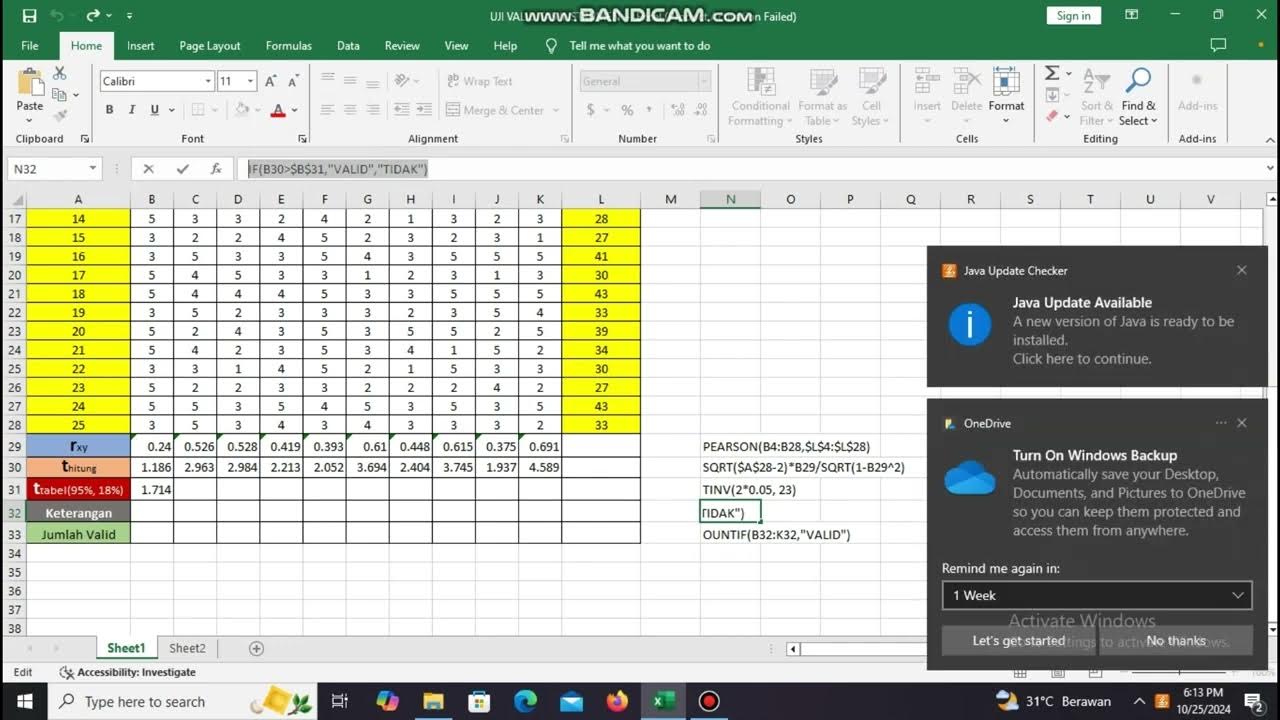SEM Series (2016) 5. Confirmatory Factor Analysis Part 2
Summary
TLDRIn this video, the presenter guides viewers through the process of Confirmatory Factor Analysis (CFA), detailing steps for conducting validity and reliability checks using a new Excel tool. Key findings highlight issues with discriminant validity and common method bias, suggesting corrective actions such as item removal and imputation of factor scores. The importance of model fit is emphasized, with metrics like CFI and RMSEA demonstrating a satisfactory outcome. Ultimately, the video serves as a comprehensive tutorial for researchers looking to enhance their CFA methodologies and ensure robust data analysis.
Takeaways
- 😀 The next steps in the Confirmatory Factor Analysis (CFA) involve conducting a validity and reliability check, assessing common method bias, and evaluating model fit.
- 📊 A new version of the validity tool is available, featuring an updated look and a variances table for more accurate estimations.
- 🔍 It is essential to ensure that data for the correlations table and standardized regression weights is accurately copied to perform the analysis.
- ⚠️ Problems with the model, such as discriminant validity issues, can be identified and addressed by analyzing the correlation matrix and maximum shared variance.
- 🔧 Deleting low-loading items can improve the model's convergent validity and overall fit.
- 📝 The validity and reliability results should be reported, indicating that convergent validity is evidenced by Average Variance Extracted (AVE) above 0.5 and Composite Reliability (CR) above 0.7.
- 📉 Common method bias can be assessed using a marker variable and comparing the unconstrained model to a fully constrained model.
- 📊 The significance of shared variance from the common method bias test can influence the analysis of factor scores in the final model.
- 🔄 When imputing factor scores, the common latent factor should be retained to account for shared variance, simplifying subsequent analyses.
- ✔️ The final measurement model fit can be evaluated even with the common method factor included, and the results should be documented, including CFI, RMSEA, and SRMR values.
Q & A
What is the main purpose of using the new 'Validity Master' tool?
-The new 'Validity Master' tool is designed to perform validity and reliability checks more accurately than the previous version, including the estimation of variances and composite reliability.
What are the key tables needed from the initial model for the analysis?
-The key tables needed are the correlations table and the standardized regression weights table. These are pasted into the new tool to facilitate the analysis.
What does the analysis reveal about discriminant validity between 'information acquisition' and 'decision quality'?
-The analysis shows a discriminant validity issue, as the square root of the average variance extracted for 'information acquisition' is less than its correlation with 'decision quality.'
What are two suggested methods for addressing the identified problems?
-One method is to delete problematic items with low loadings, and another is to run an Exploratory Factor Analysis (EFA) to identify and address cross-loadings.
How do you confirm convergent validity in this analysis?
-Convergent validity is confirmed when the average variance extracted (AVE) is above 0.5, indicating that the items effectively measure the intended construct.
What is the significance of conducting a common method bias (CMB) test?
-The CMB test checks for shared variance among observed variables that could artificially inflate relationships between them, potentially skewing results.
What steps are taken to test for common method bias?
-A common latent factor is introduced in the model, and a K-squared difference test is conducted to compare the unconstrained model with a model where all paths to the common latent factor are constrained to zero.
What does a significant result from the K-squared difference test indicate?
-A significant result indicates that there is shared variance among the items, suggesting the presence of common method bias, which necessitates the retention of the common latent factor in the analysis.
What is the outcome of the final measurement model fit after including the common latent factor?
-The final measurement model fit yields satisfactory indices, including a CFI of 0.964 and an RMSEA of 0.045, indicating a good fit for the model.
What is the final step in the CFA process described in the transcript?
-The final step is imputing factor scores, which simplifies the data representation by creating new variables that account for shared variance explained by the common latent factor.
Outlines

This section is available to paid users only. Please upgrade to access this part.
Upgrade NowMindmap

This section is available to paid users only. Please upgrade to access this part.
Upgrade NowKeywords

This section is available to paid users only. Please upgrade to access this part.
Upgrade NowHighlights

This section is available to paid users only. Please upgrade to access this part.
Upgrade NowTranscripts

This section is available to paid users only. Please upgrade to access this part.
Upgrade NowBrowse More Related Video

SEM Series (2016) 4. Confirmatory Factor Analysis Part 1

Confirmatori Factor Analysis dengan SEM

Penilian Kapabilitas, Uji Validitas dan Uji Reabilitas Cronbach Alpha di MS Excel

Cara Uji Validitas dan Reliabilitas Kuesioner Menggunakan Aplikasi SPSS | Tutorial SPSS

🔴 Lebih Mudah! Cara Uji Validitas dan Reliabilitas Dengan Excel | Uji Validitas dan Reliabilitas

Factor Analysis | What is Factor Analysis? | Factor Analysis Explained | Machine Learning | Edureka
5.0 / 5 (0 votes)